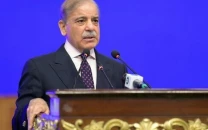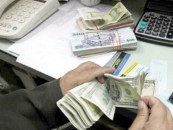US slaps higher duties on Pak competitors
Pakistan is one of those countries which do not deem the tariff war unleashed by US President Donald Trump as a threat

The United States has imposed reciprocal tariffs on different countries, including Pakistan to manage trade deficit and revive its manufacturing sector, seen by some as a threat to their exports, whereas some other look at it as an opportunity to boost their exports.
Pakistan is one of those countries which do not deem the tariff war unleashed by US President Donald Trump as a threat rather takes it as an opportunity to enhance its exports of textile products to the world's biggest market.
Pakistan's key export is garments and home textiles – around 70-80% of the country's total exports to United States. Banlgadesh and China are the main competitors of Pakistan in this area, and these two countries also faced higher tariffs that would open opportunities for Pakistan, according to experts.
Trump announced the imposition of 29% duties on Pakistani goods, along with 26% on imports from India, 37% on Bangladesh, 44% on Sri Lanka and 46% on Vietnam. Furthermore, a tug of tariff war between US and China might also open avenues for Pakistani products like corn, meat and sports goods.
In 2020, US imports stood at $2.4 trillion, rising to $3.3 trillion in 2024 but resulting in a $1.2 trillion trade deficit. To manage this deficit, the US is imposing tariffs instead with a view to encouraging local manufacturing rather than banning trade outright.
Pakistan's trade with the US is valued at $5.5 billion, ranking it 33rd among the US exporters. The US has imposed a 29% tariff on Pakistani exports. Of the total $5.5 billion in exports, garments account for $3.2 billion, while home textiles stand at $1.5 billion.
Bangladesh competes with Pakistan in the garment sector, while China is a key competitor in home textiles. Both China and Bangladesh have faced higher dutiesChina at 54% and Bangladesh 37% creating opportunities for Pakistan.
In garments, Pakistan enjoys an 8% advantage, and in home textiles, a 25% advantage due to these higher tariffs on its competitors. India faces a 26% tariff compared to Pakistan's 29%, giving it only a 3% advantage.
"This is not a significant benefit for India, and Pakistan can compensate by diversifying its trade with other partners," an official told The Express Tribune. "The total impact of US tariffs on Pakistan is estimated at $600 to $700 million, which could be offset through trade diversion."
Officials said that Pakistan had the opportunities arising from US-China tariffs war in various sectors, while there were sectors still having the US tariff exemptions. For example Pakistan exported $130 million worth of plastic polyethylene terephthalate (PET) and the US duty exemptions were still intact.
Pakistan, the officials added, could increase corn exports. The US is a major corn producer, while China was a key buyer. Due to the tariff, Pakistan had a chance to capture a share of the Chinese market. Pakistan's corn exports rose from $12 million in 2020 rising to $347 million in 2023.
Similarly, Pakistan can also capitalise on the opportunity for meat exports to China, which has traditionally sourced meat from the US. Five years ago, Pakistan signed a memorandum of understanding (MoU) with China, and its meat exports have now reached $375 million.
"The net impact of these opportunities, despite some challenges due to US tariff policies, could be around $250 million," the official estimated. "Pakistan has the opportunity to expand exports in meat, corn, and sports goods. Provinces should offer incentives to livestock and agri sectors to boost exports."
The demand for sports equipment is also high in China as well as the US, presenting another market for Pakistan. "However, Pakistan needs an aggressive marketing to take advantage of these opportunities," a Commerce Ministry official stated.
He noted that Pakistan faced a $1 billion trade deficit over the past eight months. However, higher remittances were expected to offset the impact, with projections of $35 billion in remittances this year. "There will be no dollar crisis in the country," he assured.
Pakistan is also looking towards African market and the Gulf Cooperation Council (GCC) countries to divert its trade. Pakistan and the GCC countries are at an advanced stage to sign a free trade agreement (FTA), according to the officials.
Countries like Japan rely heavily on exports, so any decline in trade with the US would impact their GDP. However, Pakistan's GDP is not export-dependent, with exports contributing only 8%. Therefore, changes in the US trade policies will not significantly impact Pakistan's GDP.
US trade
The US imports amount to $3.36 trillion in 2024. The share of Mexico stood at 15% followed by China, Canada, Germany and Japan in range of 5-14%. Out that total trade, the share of Pakistan amounts to 0.16% in 2024.
However, the share of its competitors was higher as Vietnam's share stood at 4.2%, Bangladesh 0.26%, Sri Lanka 0.09% and India 2.7%. Experts say that Pakistan has been depending on textile exports to the US but now the higher duties on competitors would enable Pakistan to diversify its exports to US.
"Pakistan has an opportunity to increase exports of textile to the US due to higher tariff imposed on its competitors like Bangladesh, Vietnam and China," Textile Association General Secretary Shahid Sattar said. He added that Pakistan would still be facing competition from Indian textiles in the US market.
"We believe, theoretically, due to Pakistan's duty disadvantage with India, Pakistan textile exports may face some pressure, however, higher duties on Bangladesh and Vietnam shall provide some respite to Pakistan exports in US," the Topline Research said in a report.





















COMMENTS (1)
Comments are moderated and generally will be posted if they are on-topic and not abusive.
For more information, please see our Comments FAQ